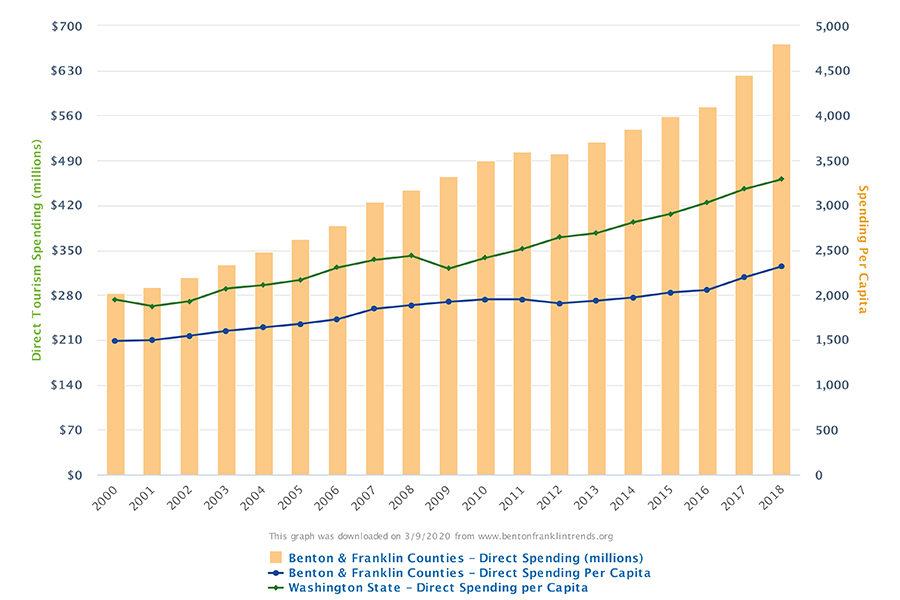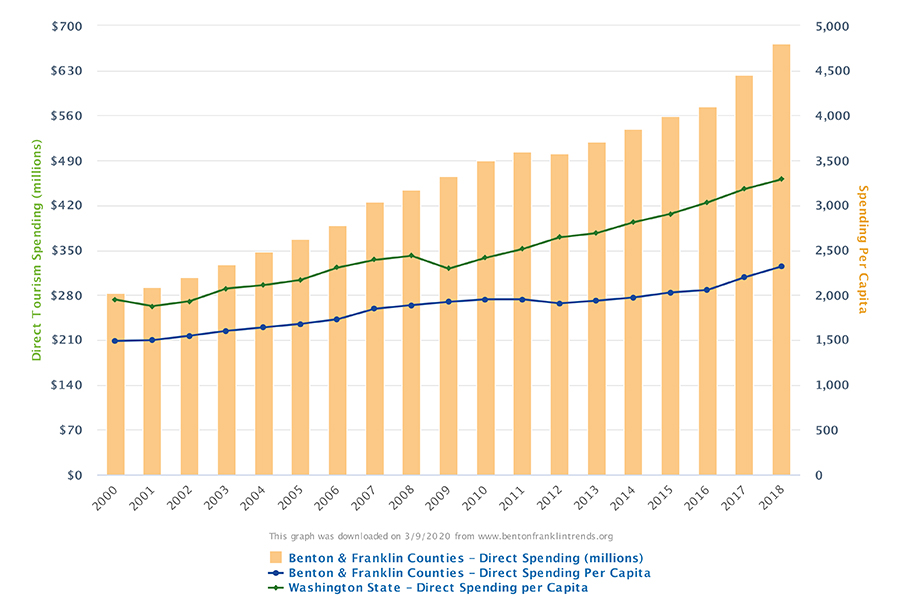
Home » Hospitality sector carving out bigger chunk of greater Tri-City economy
Hospitality sector carving out bigger chunk of greater Tri-City economy

March 16, 2020
By D. Patrick Jones
Ranking sixth doesn’t land an industry much coverage in Benton-Franklin Trends. For display purposes, only the top five sectors find their way into our graphs, such as the one covering the five largest sectors by employment. The hospitality industry of the greater Tri-Cities finds itself in this situation.
Defined by headcount, hospitality trailed government, health care and social assistance, agriculture, retail and administrative/waste services. But with nearly 10,000 people, hospitality is a force in the local economy. And as we’ll take up here, the sector’s activities contribute significantly to economic development.
Over time, the sector has grown—in numbers and ranking. Ten years ago, it employed about 7,200, putting it as the seventh largest in the two counties. Since 2003, hospitality has been one of the three fastest-growing sectors in the local economy, increasing by 63 percent cumulatively. Only health care and construction have added workers at a faster clip.
What is the hospitality sector? In contrast to many others, it consists of only two industries: accommodations and eating-and-drinking establishments. In other words, it combines activities by visitors and by residents who dine outside of the home.

Both industries have expanded considerably in the past decade. Lodging establishments in the two counties have grown from 44 in 2008, to 60 in 2018, or about 33 percent. (Data from 2019 are not yet available.) Over the same period, population in the two counties went up by 23 percent.
The growth in hospitality revenue is even more impressive. In terms of taxable retail sales, the greater Tri-City hospitality firms reported about $90 million in 2018 to the Washington Department of Revenue. In 2008, the same report showed about $55 million in sales. That’s a 64 percent increase.
Eating-and-drinking businesses tell a similar growth story. In 2018, there were a total of 428 in the two counties. That represents a 32-percent increase over the 2008 count, when the area claimed 324. Since the number of restaurants grew at a more rapid pace than population, the “intensity” of restaurants deepened in the greater Tri-Cities. Currently, about 677 residents support one restaurant, down from 2008 when the ratio stood at 727.
The eating-and-drinking industry, not surprisingly, contributes much more to the total sales than accommodations in the category. In 2018, total taxable sales by food-and-drink establishments were more than $487 million. That was more than five times the total sales in the accommodations sector. A large number? Yes. But from a perspective of growing the economy, only those meals and drinks paid by visitors inject “new dollars” into the two-county economy.
Expenditures by residents, while great for restaurants-and-drinking establishments, essentially recirculate existing dollars in the economy and supplant sales of other sectors. Imagine, for example, that 50 percent of meals served in restaurants suddenly was produced at home. Grocery stores would see a big benefit as they supply, by large measure, food in the home. For sure the current, broadened choices of food and drink are welcome to residents, contributing to the quality of life here.
A brief note on tourism—the sector that, by definition, rests on transactions from those living outside the counties. Trends data tallies not only sales in the hospitality sector, but also in retail, transportation and entertainment. The data source is the industry standard, Dean Runyan, and comes courtesy of Visit Tri-Cities. Not surprisingly, the most important spending categories are: meals, lodging and air transportation—in that order.
What does this indicator tell us? Most importantly, that tourist spending, estimated at $672 million in 2018, has increased by 51 percent since 2008. On a per capita basis, visitor spending hasn’t increased nearly as much, as is obvious from the data. A per capita measure gives some idea of the “tourist intensity” of a jurisdiction, that is, how important it is. Here, the measure shows us that per capita spending has trailed the Washington average and continues to do so. But let’s not put too much weight on this measure, since the denominator, population, has grown much faster here than across the state.
To this observer, the hospitality industry is a large and vital one to the Tri-City area economy. Some its strong growth can be traced simply to rapid population growth, especially in the restaurant sector. Some of it also can be traced to relatively high income levels. A higher frequency of eating out correlates positively with rising incomes. And a good part also can be traced to the rise of visitors, whether for business, meetings, sports, culture or recreation.
D. Patrick Jones is the executive director for Eastern Washington University’s Institute for Public Policy & Economic Analysis. Benton-Franklin Trends, the institute’s project, uses local, state and federal data to measure the local economic, educational and civic life of Benton and Franklin counties.
Local News Hospitality & Meetings
KEYWORDS march 2020




